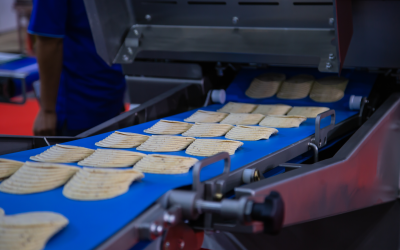Working at FSNS, I have investigated several spoilage studies on low moisture products. In some of the instances, the spoilage of the finished commodities were due to usage of raw ingredients that had not been adequately heat treated or processed. For example, spoilage in liquid sauces were observed because of the use of dry spices that had higher levels of spoilage organisms. Similarly, other foods that used raw flour had decreased shelf life. Thermal treatments are one of the best ways to treat such low moisture products before they can be used as an ingredient to make the final food commodities. However, higher treatment temperatures are needed to obtain sufficient amount of log reductions of naturally occurring microorganisms on the foods. The use of such high temperatures can not only affect the sensory properties of the foods, but may also make it unusable. For example, heat treatment of flour can affect the functionality, such as dough consistency and/or affect the nutrient levels. In addition, the product may be cooked due to the use of the high temperatures. Besides the spoilage concern, presence of pathogens are another big issue in ready to eat products. Effective treatment technologies are needed to reduce pathogens to a safe level while also helping maintain the original qualities of the raw ingredients and products. Vacuum Steam Pasteurization (VSP) is a technology that may be the answer for obtaining such results.
The VSP system uses steam for the thermal treatment under a controlled negative pressure i.e. under vacuum, hence the name vacuum steam pasteurization. Under normal circumstances, steam is generated at 100°C or above but a VSP unit under a lowered pressure in a closed system can generate steam at lower treatment temperatures. The benefits are that the system provides effective treatment with a) steam- which has higher thermal transfer coefficient as compared to boiling water or other forms of heat treatment leading to effective reduction of microorganisms, b) lower treatment temperature likely has no adverse effect on the product quality, c) the vacuum applied during the treatment can be applied at post treatment cycles to minimize gain in moisture, leaving minimal impact on product’s water activity or moisture content, helping maintain normal shelf life, and d) this system is chemical free, which is one of the most desired attributes preferred by consumers and processors alike.
The effectives of this technology has been shown in various research studies and are also currently being used in the industry. My Master’s work investigated the efficacy of VSP on inactivation of Salmonella, and E. coli O157:H7 on several product types, such as whole flaxseed, ground flaxseed, peppercorns, whole wheat, sunflower kernels, and quinoa (1). The lowest temperature that was investigated in this study was 75°C and 3-5 log reductions were observed on most products for the targeted pathogens for a treatment time of 5 minutes or less. Treatment at 85C provided, as much as a 5 log reduction within 30 seconds. Another study determined the effect of VSS on microbiological physical/chemical shelf life attributes (2). It was determined that the VSP system did not have any significant adverse effect on the chemical attributes (fatty acid profile, peroxide values, oil, SDG contents etc.). Similarly, the VSP led to decrease in Total aerobic plate counts and Yeasts and Molds. Also, there was very little effect on water activity over six months of storage period.
Another study conducted on hard red spring wheat from NDSU researchers showed that the quality of flour was not affected. Outbreaks in flour due to E. coli O121 have been reported and this study not only showed that VSP is effective in the reduction of the pathogens of concerns, but also is helpful in maintaining the baking properties of the flour (3). The treatment study showed a temperature as low as 65°C to be effective. Similar studies have been conducted by another group of researchers at Virginia State University (4). They shave shown the effectives of the VSP unit in obtaining effective reduction of pathogens in several products, such as cumin seeds, peppercorns, pecans etc.
Determining the efficacies of the VSP treatment system on pathogens inoculated on various food types, the researchers also showed that certain non-pathogenic organisms, such as E. faecium can be used as surrogate organisms. This information is helpful for processors to conduct in-plant validation studies using the VSP system. Current research shows effectiveness of the VSP system on various low moisture food products that are either grains, flour seeds or nuts. A few spices, such as cumin and peppercorns has also been investigated. More research is needed to investigate the use of VSP on other dried spices. The system can definitely be used on other product types and their usage is being increasingly explored through continued research (5).
The VSP treatment system is already in use in the industry to achieve appropriate log reductions for foodborne pathogens. Food products that are of low moisture in origin can be considered for treatment using VSP system since this system is not only effective in spoilage reduction and pathogen control but also causes minimal effect to the product.
References:
- Shah, Manoj K., et al. “Efficacy of vacuum steam pasteurization for inactivation of Salmonella PT 30, Escherichia coli O157: H7 and Enterococcus faecium on low moisture foods.” International journal of food microbiology244 (2017): 111-118.
- Shah, Manoj, et al. “Microbial and Chemical Shelf‐Life of Vacuum Steam‐Pasteurized Whole Flaxseed and Milled Flaxseed.” Journal of food science2 (2018): 300-308.
- SNELLING, JANE, et al. “Effect of Vacuum Steam Treatment of Hard Red Spring Wheat on Flour Quality and Reduction of Escherichia coli O121 and Salmonella Enteritidis PT 30.” Journal of Food Protection5 (2020): 836-843.
- Newkirk, Jordan J., et al. “Inactivation of Salmonella enterica and surrogate Enterococcus faecium on whole black peppercorns and cumin seeds using vacuum steam pasteurization.” Frontiers in Sustainable Food Systems2 (2018): 48.
- NDSU Researchers Receive Grant to Reduce Pathogens in Flour. 2020. https://www.ndsu.edu/news/view/detail/58157/



